An in-depth guide to customer interaction management

VP of Customer Experience

Customer Support Manager - Tier 1
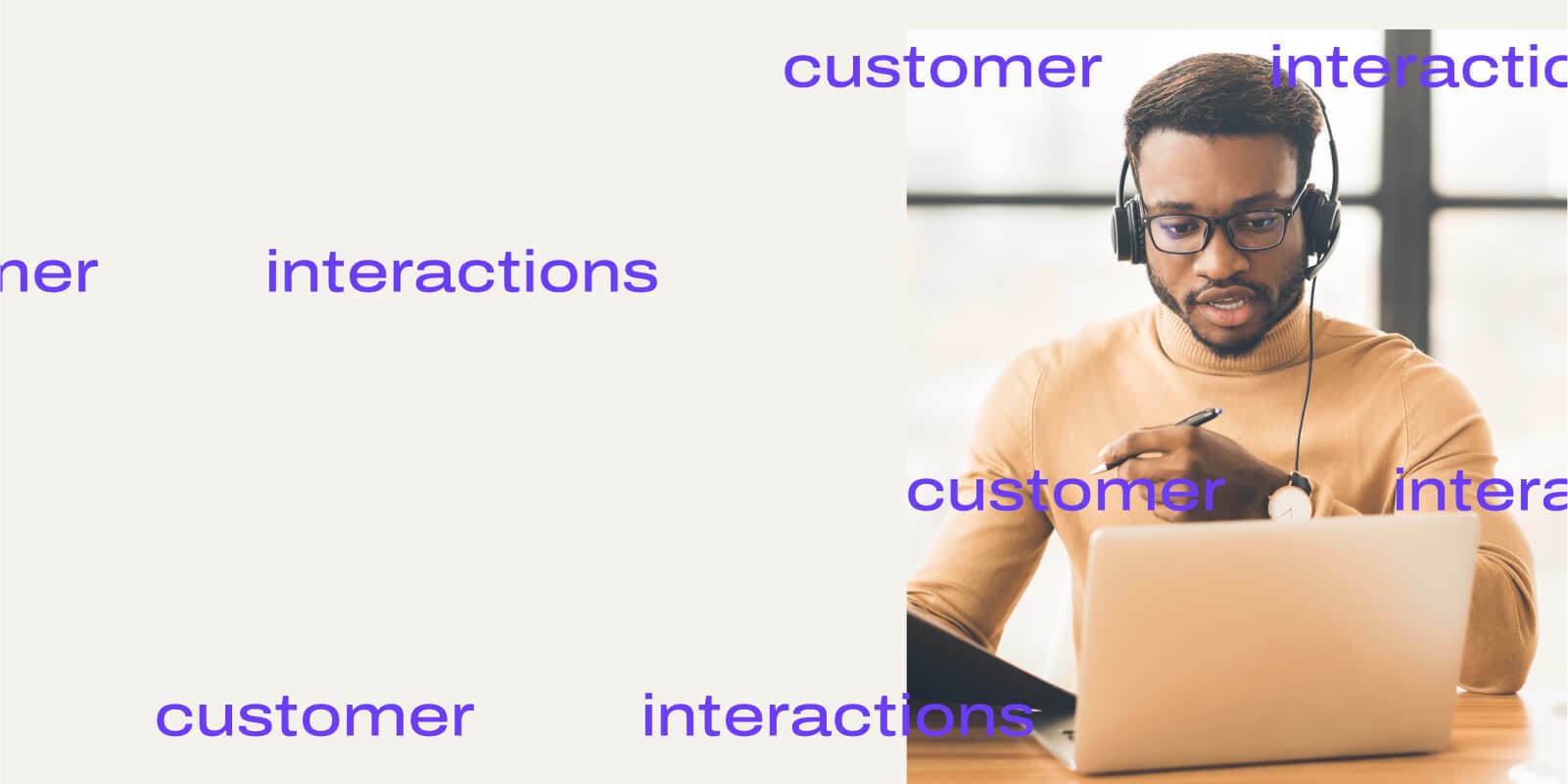
Tags
Share
What turns new customers (and existing customers) into brand loyalists? The quality of your products and services, and the degree to which they meet a customer’s needs are important factors, sure, but they’re not enough.
Even if they’re great and your customer satisfaction scores are pretty good, that’s not always enough to keep people coming back.
You need a great customer experience.
And customer interaction management (CIM) is one key building block of providing that great experience.
But what if your company is interacting with customers on a whole range of channels? How can you make that easier for your agents (or yourself) to manage?
What is a customer interaction?
A customer interaction is pretty self-explanatory—it’s any conversation or communication you have with a customer. There are a ton of different types of interactions including when customers reach out to your business with questions, complaints, praises, suggestions, and so on.
Customer interactions can also be proactive on your part. It doesn’t always have to be the customer reaching out! For example, you emailing a customer to fill out a survey could also count as a customer interaction.
What is customer interaction management?
Essentially, customer interaction management (also sometimes called CIM), is about how a business or organization handles its conversations with customers—usually, on a range of different channels.
The easiest way to do this is often to use customer interaction management software, which is especially effective in places like contact centers, where most interactions happen.
These customer interaction management solutions should cover communication channels like phone calls, emails, live chat, and more (which we’ll get into later). Regardless, though, the key is to offer consistently great service to your customer base no matter which platform they’re contacting you on.
Why is CIM so important for businesses?
It improves the customer experience
Being able to handle customer interactions and resolve their questions or problems quickly is a great way to improve your customer satisfaction metrics.
The thing is, customers don’t always reach out on just one channel either. If someone has a great phone experience with your company, but never gets a response on live chat or email, that could undo all the great work your phone agents are doing.
Always consider your customer journeyholistically.
It builds stronger customer relationships (which helps with loyalty and retention)
A better customer experience results in customers who stick around longer—and spend more money with your business. And you don’t always need to have an extravagant loyalty or referral program.
How can you make the interactions that you’re already having with your customers the best they can be? How can you make that customer interaction cycle as efficient as possible?
All of these optimizations for different channels will take a lot of work, yes. But how much are happy customers (who keep spending money on your business) worth?
For many businesses, they’re priceless.
It reduces churn
On a related note, if you can keep more customers for a longer time, you can also reduce churn.
For subscription-based businesses, this is an especially challenging problem. Customers leave for many reasons (a change in pricing is probably a big one) and often, even one bad service interaction can topple all the hard work you did to build that relationship. Unavoidable mishaps happen, of course, and you can’t always prevent slip-ups. But you can minimize the chances of those happening.
✨ Provide a better customer experience
Get The Contact Center Playbook, which breaks down everything you need to know, from setup to staffing to optimizing—with examples from real contact center teams across different industries.
Customer interactions span every part of the customer journey
Awareness of the product
For example: The customer becomes aware of your product and uses their preferred channel to get more information about your company.
Evaluation by the customer
For example: Once the customer is aware of your company, they'll evaluate the suitability of your product and compare it to your competitors. (Maybe they’ll ask for a demo.)
Investment
For example: At this stage, the customer has completed their evaluation and is ready to commit to your product. If it’s a more complicated service or product, your Legal or Finance team might get involved.
Post-purchase experience
For example: After the customer has purchased your product, how can you make sure every interaction is positive and helps them get the most out of your product? Do you have a clear onboarding or setup process?
Upsell and cross-sell
For example: Do you forget about a customer after they’ve given you their credit card information? Or do you send them regular emails and surveys to stay in touch, or offer discounts to get them to make a repeat purchase? Maybe you have a referral program that rewards them for telling their friends or colleagues about your business.
Where do customer interactions happen? (The channels to watch)
Over the phone
Fun fact: Nearly half of the time when millennials get in touch with businesses, they use their phones to call them.
No matter how much people love to say that phone calls are dead, there are still some special situations where calling a company is going to be the preferred way to get in touch with them. (For example, when an issue is urgent and someone doesn’t want to wait days, or even more than a few minutes, for an answer.)
You may have noticed that some companies have removed their phone numbers altogether from their websites to try to drive customers to other channels, but this isn’t always wise. Of course, you may decide that the financial advantages are worth it and it may be a good idea in the end. (Your customers will let you know.)
Social media
Twitter, TikTok, Facebook, LinkedIn—the list of social media platforms businesses need to get involved on is getting longer. But you can’t ignore these touchpoints, because everyone’s online. (You may as well use that to your advantage and encourage customer engagement on your social media channels.)
One neat thing about Dialpad Ai Contact Center is that it lets us manage all our communication channels, including social media, in one place. It's a true omnichannel solution:

Live chat
Live chat (and to a lesser degree, chatbots) is one of the most popular digital channels for customers to contact businesses.
The nice thing about live chat is it happens in real-time and pretty much comes with all the benefits of phoning a business—and none of the associated phone anxiety. For businesses that are undergoing a digital transformation, this is a key customer channel to have.
Text or SMS
For less immediate concerns or questions, messaging or sending an SMS is a great way to reach businesses. Like live chat, customers won’t have to talk to someone on the phone if they don’t feel like it.
This is also a good touchpoint for accessibility because it can be useful for folks who struggle with auditory processing, understanding accents, and/or pronunciation.
Email is one of the most popular customer service channels, and you’ll likely get quite a few emails from customers on a daily basis. The nice thing about email is that customers don’t tend to expect as much—if someone calls you, they don’t want to wait on hold at all.
But with email, customers are usually more lenient and you can respond within a day or two. Emails are also great paper trails and give you proof of what was discussed.
If you have multiple teammates managing incoming emails, a shared inbox platform like Front might be a good tool to have. (Front does integrate with Dialpad, which allows agents to message and call each other directly from the Front dashboard if they need to work together to resolve more complicated issues.)
Video call
This is more for very specific types of businesses and industries, but some customers or clients do prefer to video call you. (For example, if you provide financial services to high-net-worth clients, they’d probably want to have face-to-face conversations with you.)
And if you want to give your clients a smooth video calling experience that doesn’t require them to download something to meet virtually with you? Dialpad lets you host—and join—video meetings from a web browser:
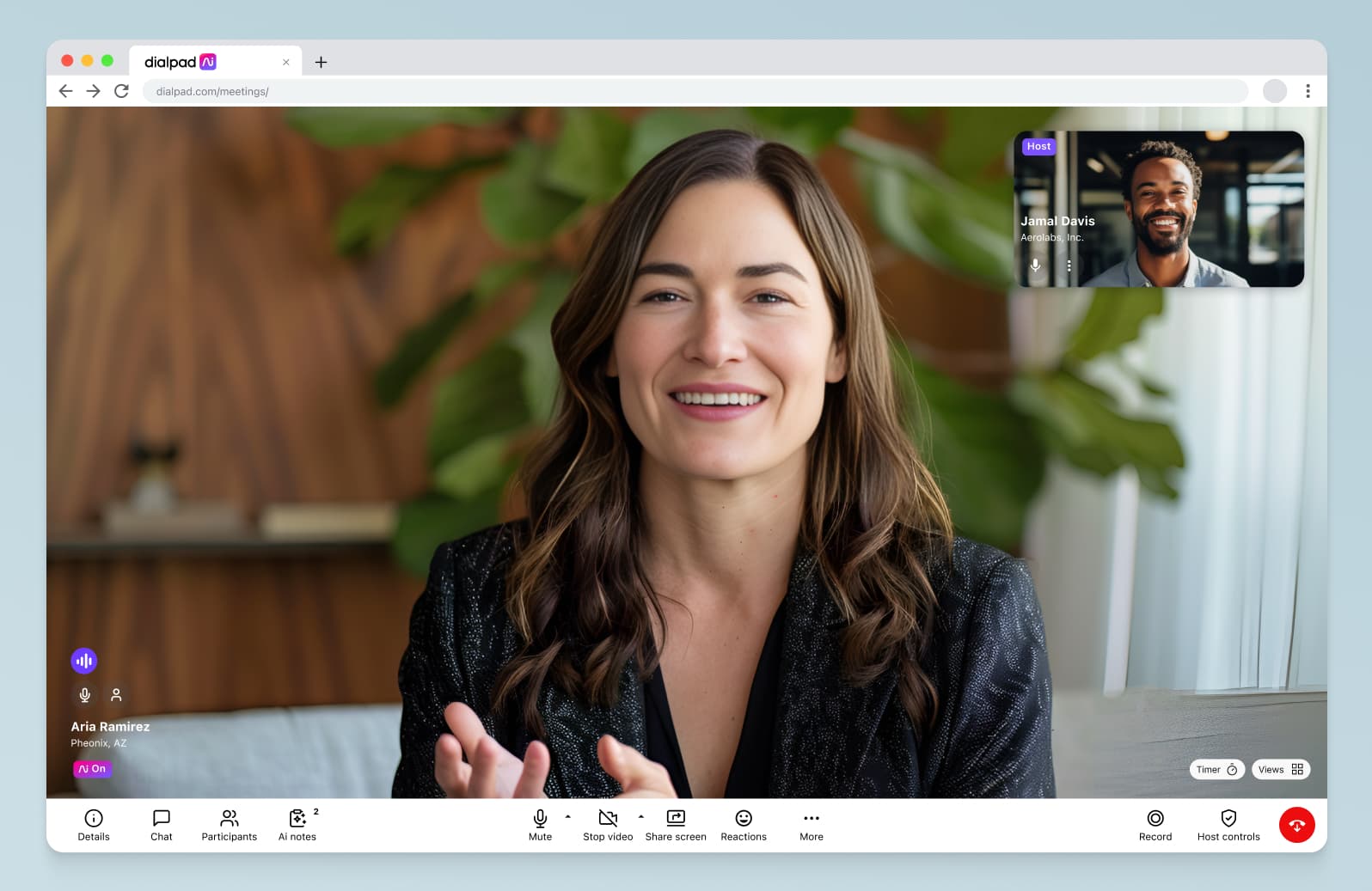
What prompts customer interactions?
Now, let’s look at a few common types of customer interactions you should be prepared for.
Questions and general concerns
If you haven’t been the person who ends a presentation with “any questions or concerns?”, chances are you’ve heard someone else say it.
Questions and concerns are one of the most common reasons why customers contact brands.
So, how can you turn these questions and customer feedback into useful information that can help you improve the customer experience?
We mentioned software earlier and as an example, Dialpad's cloud contact center solution is powered by our proprietary artificial intelligence, which can transcribe customer calls in real time.
But not only that, it can also track keywords and phrases that come up in these calls. For example, if you want to know how frequently customers are asking about a new special or asking for refunds, you can set Dialpad to track these as Custom Moments:
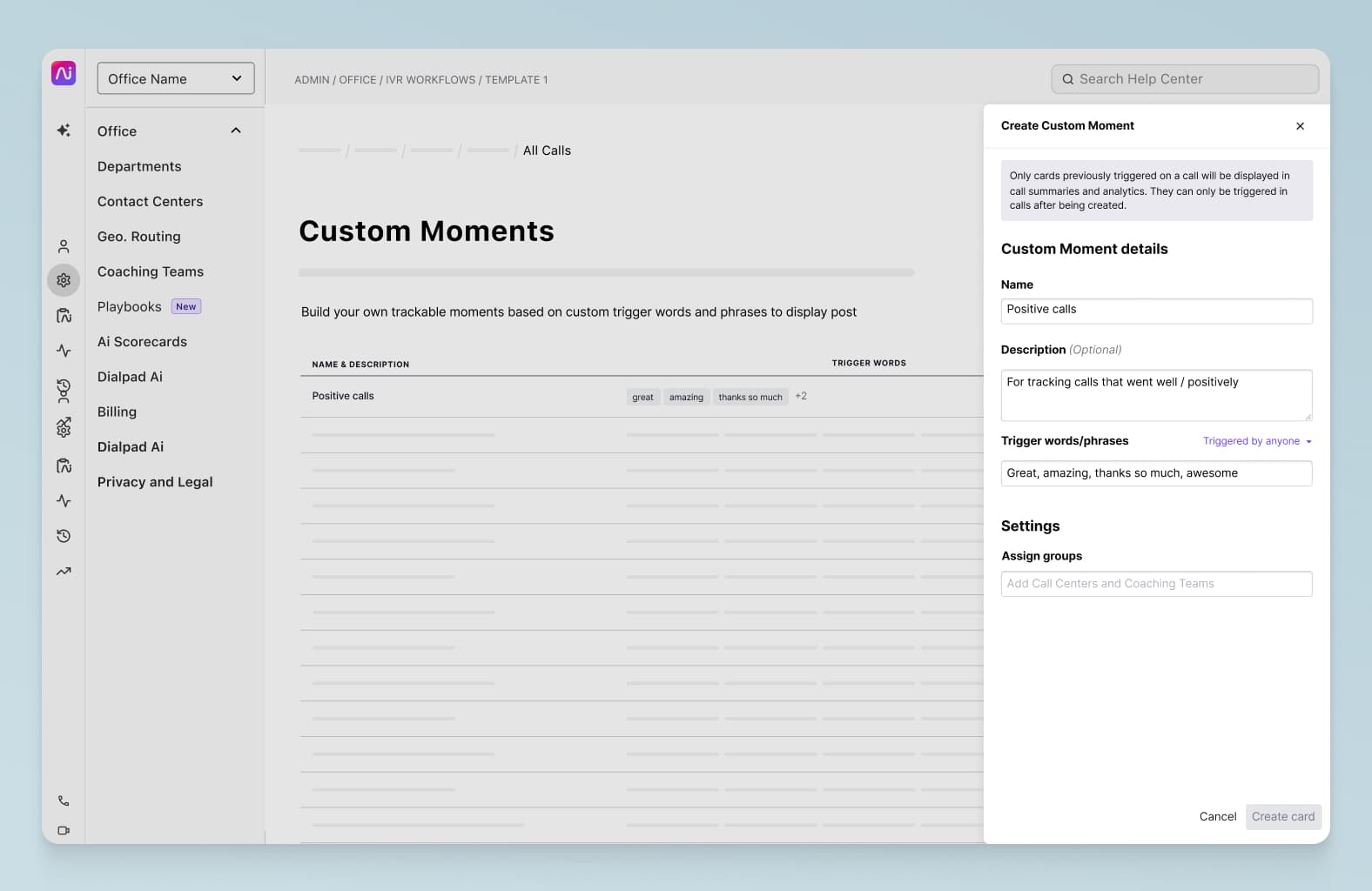
You can set it track, say, every time “refund” or “money back” comes up in a conversation—which you’ll then be able to see in Dialpad’s analytics dashboard over time.
Complaints
Nobody likes hearing how badly they did or where they messed up. Still, customers are going to have complaints about even the best of businesses, and a good support team should be ready to take these on.
The thing about customers is they’re going to share their user experience with their network—whether that experience was good or bad.
You can either let them give you bad word-of-mouth publicity or you can open your business to receiving (and resolving) complaints at your contact center or call center. This way, you can improve your customer interactions and manage your reputation.
Praise
Here’s one thing that every customer support agent will love: praise.
Criticism can be a great tool to help you improve—but so can glowing feedback. Knowing where you are meeting or exceeding customer needs is important, and these are the areas where you want to keep doing exactly what you’re doing.
And to continually optimize your on-the-phone and digital customer experience, you need a way to get more feedback from your customers (hopefully it’s praise, but no guarantees). One common way is to use customer satisfaction (CSAT) surveys. You can send these to your customers over different channels after an interaction with them, and yes, you can do CSAT surveys over the phone too.
With Dialpad, you can quickly create a CSAT survey in a few seconds and set it to automatically play after a call.

You can even add an option for your customer to elaborate on why they gave you the score they did!
Of course, one of the biggest challenges by far with CSAT scores is that not a lot of people actually fill out those surveys.
In fact (depending on the industry and specific business of course), we've found that on average only about 5% of customers actually fill out CSAT surveys. On a related note, usually only the angriest—and happiest—customers actually bother to respond to these surveys, which means your CSAT answers are likely to be very skewed and not representative of how your customers feel overall.
Dialpad's industry-first Ai CSAT feature is designed to solve exactly that. Not only can our Ai transcribe calls and analyze sentiment in real time, it can also infer CSAT scores for 100% of your customer calls thanks to its hyper-accurate transcription feature. The result? A much more representative sample size for CSAT scores, and a more accurate understanding of how satisfied your customers really are:

Customer support
If your business sells software or a more complicated kind of product, many of your customer interactions may end up being requests for customer support.
How are you making sure that your agents are empowered to provide good support in real time?
We mentioned Custom Moments earlier, which are great for tracking keywords, but did you know that you can take these one step further? Once you know which keywords or phrases are coming up frequently, you can create Real-time Assist (RTA) cards that’ll pop up automatically on your agents’ screens—when these keywords are spoken on the call!

This way, even newer hires can start handling customer interactions and get the information they need without feeling like they just got thrown into the deep end.
What should you look for in customer interaction management software?
As you appreciate the scope and potential for your customer interaction management software to connect the channels we mentioned above, it’s important to consider the features that can help make that happen.
Here are a few examples.
Real-time assists for agents
What happens if one manager has to oversee 10 or 20 agents at once? They can't possibly personally coach every call and help when tricky situations come up. This is where it's helpful to have some kind of real-time agent assist feature.
As we mentioned earlier, Dialpad's RTA cards are designed to do exactly this.
Cross channel support
With so many channels for customer interaction on offer, it can be easy to miss messages, particularly if you don’t check your social media inbox regularly, for instance.
Look for a platform that either lets you manage all the different channels your customers are on, or integrates with other tools and social media platforms to let you do this.
Integration with CRMs and other tools
Having all your customer interaction tools in one place makes it easier for your customer support agents to manage their time and communications.
Making use of CRM integrations with tools like Salesforce, HubSpot, and Zoho CRM (and even other customer support tools like Zendesk) can really streamline things for your agents and automate repetitive tasks for them:
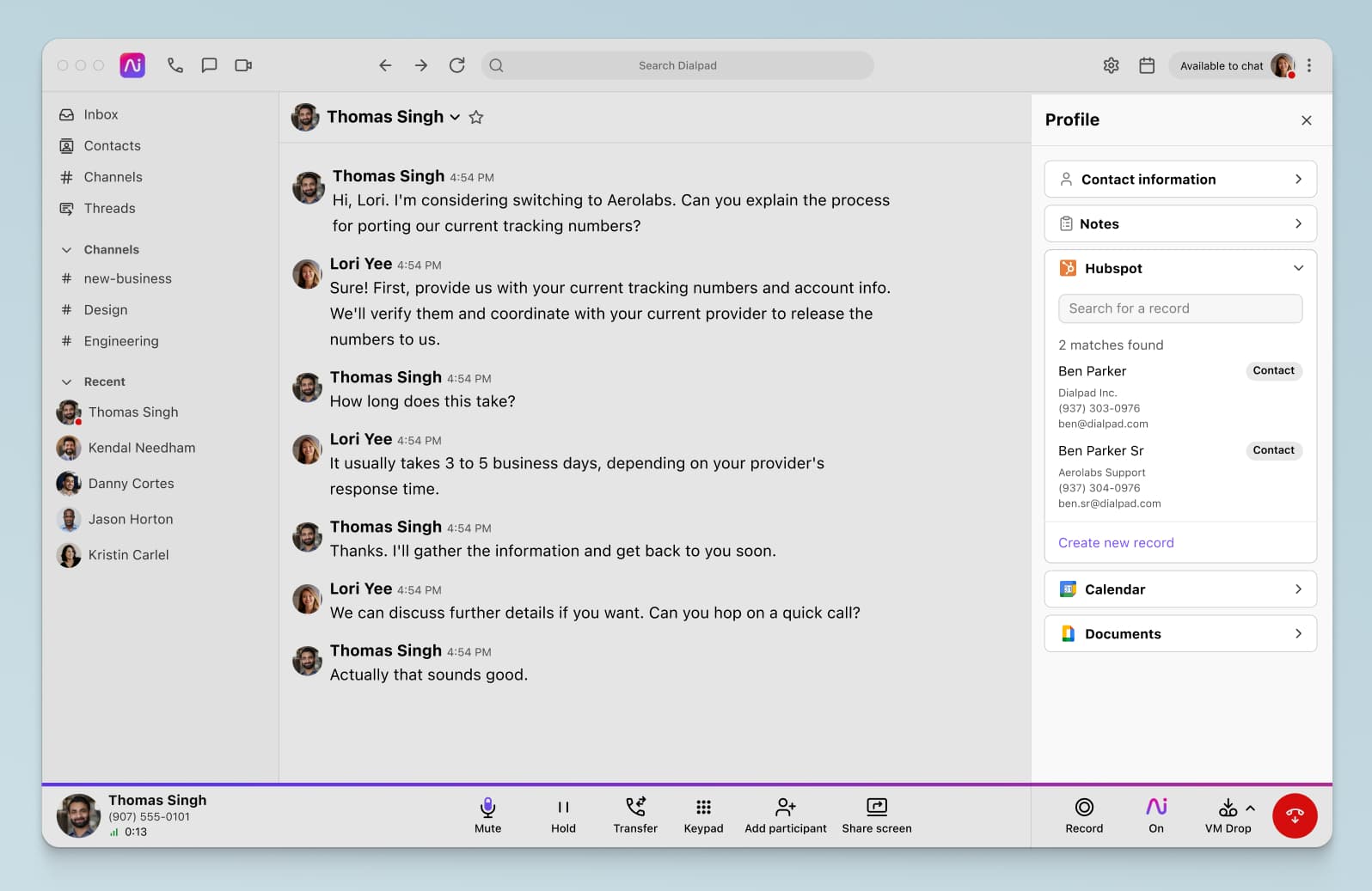
Customer feedback through CSAT surveys
Until you ask your customers for their opinions, you’re always going to be guessing what sort of experience your customer interactions are providing.
Regularly sending out and reviewing CSAT surveys allows you to monitor KPIs and highlight areas of your customer service that can be improved. These surveys also maintain your communication with customers, even if they don’t approach your customer services with questions or issues.
Real-time transcriptions
Whether your agents are on phone calls or video calls, a live transcription feature can be helpful for not only training and development, but also improving the customer experience in real time.
The 5 most common customer interactions—and how to handle them
The good news is, most of the time, your customers will interact with you in pretty predictable ways. Specifically, these interactions will probably fall under one of these situations.
1. Questions from potential customers
Potential customers interested in your product will often reach out with questions before they commit to a purchase.
How to handle these interactions
Work with your sales team to understand your most frequently asked questions.
This one is pretty low pressure. No one is mad—people are just curious about your company and want to learn more about your products or services.
Having a good unified communications or contact center platform can be really helpful here. Again, we use Dialpad to track common phrases or words that come up in our customer interactions by setting up Custom Moments.
Make sure your website content is up-to-date
There are few things more frustrating than visiting a company's website, only to find their phone number isn't right or their product information hasn't been updated in two years.
If you’re going to have a website, make sure that things like your contact, product, and pricing information are up-to-date.
2. New (and existing) customers who need help
New customers will often need help getting started with your product or service. And these first interactions are a great opportunity to make that user experience as easy for them as possible and start building those customer relationships.
How to handle these interactions
Make sure your support agents know everything about the product
If agents can answer customer questions without hesitation and get them the answers they need, customer relationships will flourish.
If an agent doesn't have the answer at the tip of their tongue, we can put it at the tips of their fingers with cheat sheets that pop up in real-time with Dialpad's Real-Time Assist (RTA) cards.
Offer a combination of self-service / live chat and voice calls for customers
Chatbots are fine, but sometimes you just need to talk to a human. Often, customers will hit up live chat first to try to solve their issues—but what if it ends up being a more complicated problem?
Dialpad Ai Contact Center handles this kind of situation really well. If your website's chatbot—or a live agent—is chatting with a customer, but needs to take it to a voice call, Dialpad gives them the option to switch the conversation to a call instantly. And the best thing is we can adjust these conversational flows with just a few clicks, no coding needed:

If you have more of a complicated product or service, it’s always good to have different touchpoints that customers can use to communicate with you.
3. Suggestions for new features and functionalities
Make the most of customer feedback, especially when it comes to suggestions for your products. Your customers are likely using your product or service every day, which means they have deep knowledge about what works—and what doesn’t.
How to handle these interactions
Know which suggestions to prioritize
Taking on a lot of suggestions can feel overwhelming. You don't want to disregard any customer ideas, but you probably won’t be able to implement them all.
Prioritize suggestions based on their value and timeliness. For example, a request for new color combinations is probably not as urgent as a suggestion to update an out-of-date how-to page.
Organize the requests and take note of similar ones
Say you’re getting lots of suggestions and requests every day. And many of them are about very similar things. How can you tell at a glance how many of these are “repeat” suggestions (and therefore, more popular and possibly more important to prioritize?
(Custom Moments, of course!)
Keep the customer updated on their suggestion
Keeping customers in the loop about their suggestions will encourage more customer engagement. As their suggestion moves through the pipeline, follow up with customers and let them know.
Of course, you won't use every suggestion. When you table a customer suggestion, reach out and let them know why—”closing the loop,” even if it’s not the answer they necessarily wanted, is key to the customer experience and is generally better than just ghosting them or leaving them hanging because you’re afraid of saying no.
4. Unhappy customers airing their complaints
No matter how well you run your company or how skilled your support team is, you're going to have unhappy customers who reach out to complain.
Make sure your agents are well-versed in handling negative client interactions. An employee who is short with a customer or doesn’t show empathy will only make things worse. Set your employees up with training and help them build their active listening skills.
Other than the automations we mentioned above, Dialpad also has a useful customer sentiment analysis feature that shows us how calls are going in real time. If you’re a contact center supervisor, this can be a lifesaver.
How it works: we can’t listen in on every single customer call to make sure it’s going well, but we can see a running list of active calls and the sentiment of each one:

This way, we can see which calls have a negative sentiment, read the transcript (which gets updated in real time as the call is happening), and jump in if needed.
How to handle these interactions
Show empathy and try to alleviate their frustration
Resolving any issue will require attentiveness, patience, and empathy. Before they even begin to solve the problem, a good customer support agent should be able to empathize with the customer's situation. This will go a long way towards calming an angry customer.
After the customer has aired their complaints, then you can begin to gauge the situation and determine a solution.
Offer to restore any losses incurred
Restoring losses with a refund or redo will show the customer you're genuinely interested in making things right. Saying all the nice things is, unfortunately, not always enough.
Sometimes a customer just wants to vent their frustrations. In other cases, compensation, like an upgrade to a higher-tiered plan can help to relieve the frustration. In the end, you just want to make sure your customer feels like they're being heard and action is being taken.
Let them know what efforts you are making to address the issue
Make sure your customer knows you're working on the problem, but if you can't offer them a solution right away, or it's a problem you need to investigate, be honest and let them know you'll follow up with them as soon as you have a solution.
It might be tempting to give a vague answer in these cases, but we find that customers usually find that unhelpful—if you really can’t help them right now, tell them why and give them your best estimate for a resolution.
5. Loyal customers telling you they love you
And finally, our favorite: sometimes your customer interactions are easy and positive. If you’ve built strong customer relationships, your customer satisfaction scores will reflect it.
But that doesn’t mean that you can just sit back and do nothing!
How to handle these interactions
Use customer data to personalize interactions
Customer expectations are always changing, and you should always be thinking about ways to make the experience better for your customer base. This is “behind the scenes” work, but it’s essential for maintaining the customer lifecycle—and growing it over time.
For example, your customers might prefer interacting with you on certain channels or really love certain products. You can use that knowledge to nurture them over time and send them new products or deals based on what they like. (Ecommerce businesses have really mastered this.)
Establish a rewards program for loyal customers
10 stamps and you get a free ice cream, 20% off your purchase on your birthday—rewards programs are the ticket to any customer's heart.
You don't have to be in retail or hospitality to offer your customers something special. Here are a few types of rewards ideas to consider:
Birthday rewards
Customer anniversary rewards
Points program
Your chances of getting a loyal, happy customer to upgrade a product or service are generally much higher than if you asked a first-time buyer to go with a more expensive option.
Encourage brand advocacy on social media
Encourage reviews on trusted sites and social media. Make it super simple for customers. Email them links to pages where they can fill these out, invite them to interact with you on social media channels, and consider a referral program to reward loyal brand advocates.
5 tips for creating a more positive customer experience
1. Choose transparency over inaccuracy
If you’ve (either you or your team or your company as a whole) made a mistake, it’s generally best to be honest about the error and explain what happened.
Every successful business has made mistakes before. It’s how they respond to the mistake that matters, and your customers will see through any white lies or partial explanations.
2. Be receptive—and responsive—to feedback
Whether you ask for customer feedback or get it unsolicited, be receptive and appreciative of what your customers tell you. (Even a seemingly small interaction counts!)
Customer surveys are a very useful tool to hone in on what your customers want. (Again, we can create customer satisfaction (or CSAT) surveys in Dialpad to do this.)
3. Meet the customer on their desired platform
Customers should be able to reach you from their preferred platforms (some folks call this a multichannel or omnichannel approach).
Regardless, have all the options clearly listed on your website and social media—phone numbers, email addresses, messaging options, and so on. Of course, the issue with so many different channels is that it can be difficult to manage them all.
Having a good contact center platform will help you handle these customer interactions more efficiently. One great thing about Dialpad is that it has integrations designed specifically for this.
(We mentioned Intercom earlier, but Dialpad Ai Contact Center also integrates with ticketing and inbox tools like Zendesk and Front—your agents can handle tickets and also have phone calls with customers, right from inside Zendesk.)
That’s the power of customer service automation. No more toggling back and forth between windows, no more copying and pasting information.
And beyond integrations of course, we can handle all of our own communications (phone calls, SMS and instant messaging, video meetings, and agent / supervisor interactions)—in one app.
4. Map out the customer journey
Think about all the stages your customer will go through, from awareness of your product to purchase and beyond. How long does an average question or interaction take? What steps are involved? Look at your interactions in the context of the customer journey to create a better holistic experience.
5. Be proactive with customers
Proactive customer service means anticipating what a customer might need before they need it.
And to be proactive, you need to offer self-service options. An Interactive Voice Response (IVR) system can route your customers to the right departments and get them to the answers they want more quickly.
Dialpad's intuitive IVR is not only easy to set up, it also gives us analytics that show you which IVR menu options customers use most. This allows us to direct customers to self help, create fast lanes where customers can get to the information they need—and more importantly, reduce hold times:
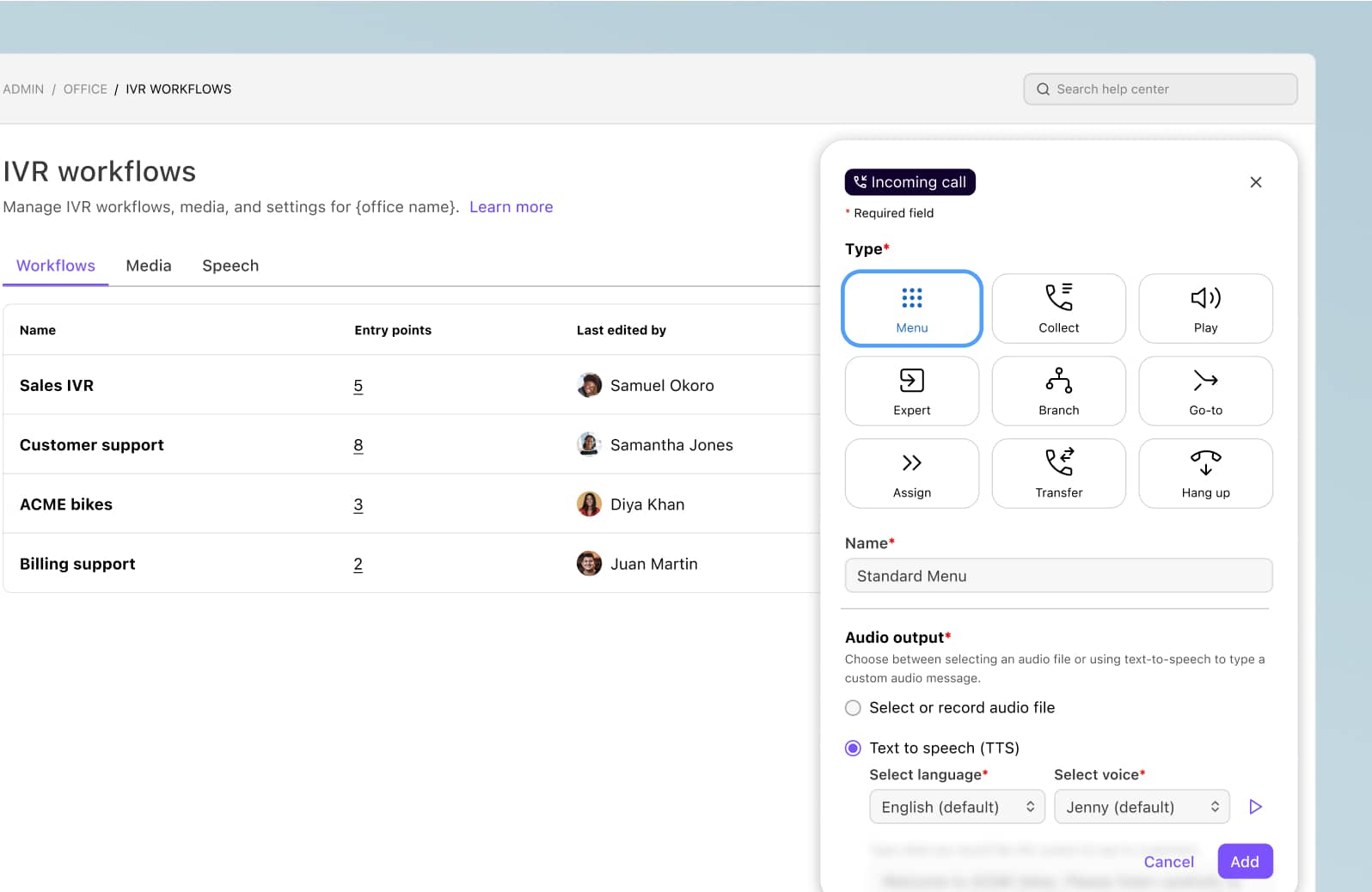
The other key piece of being proactive is training. We talked about using Custom Moments and RTA cards earlier and how my team uses these to train large groups of agents at scale, and we really can’t overstate the importance of this.
For many growing businesses, they’re not just having one or two customer interactions a day. We’re talking about tens, or even hundreds, of conversations and interactions on a daily basis. How can one person or manager oversee a large team of agents and still make sure that customers are getting what they need?
That’s the question you have to answer.
Ready to level-up your approach customer interaction management?
If you’ve ever wondered about things like how to improve customer loyalty or how to satisfy customer needs, you need to first look at your interactions.
That’s the first step, and these are the building blocks of a more consistent and personalized experience. Whether you’re a small business that’s growing quickly or a global enterprise that’s trying to increase retention, don’t let one bad experience be a setback—use every interaction as an opportunity to learn and to coach your agents better.
Customers will appreciate the attention to detail, and they’ll keep coming back.
Want to provide a better customer experience...
And help your agents manage different channels more effectively? Book a demo of Dialpad Ai Contact Center, or take a self-guided interactive tour of the app on your own first!








